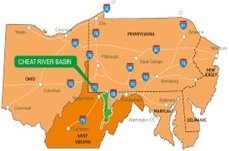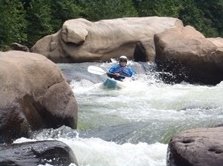Rebirth of the Cheat River
Stories of Progress in Achieving Healthy Waters
U.S. EPA Region 3 Water Protection Division
Cheat River, West Virginia • June 9, 2016
The Cheat River in West Virginia is again a haven for whitewater rafting and smallmouth bass fishing after years of Clean Water Act funding and the efforts of a local non-profit group and others to control pollution from old abandoned mines.
And while the work to treat acid mine drainage (AMD) from the river’s feeder streams continues, restoration has been so successful it’s getting harder for the rural roads to handle all the outdoor enthusiasts hoping to experience the Cheat’s wild wonders – proving that if you clean it, they’ll come.
“We’re not done, but collectively, we’ve restored the Cheat River mainstem,” said Amanda Pitzer, executive director of the non-profit Friends of the Cheat.
Since 2000, Cheat River restoration efforts have received more than $5.1 million in support, including $2.6 million in EPA Section 319 nonpoint source funding through the West Virginia Department of Environmental Protection. The U.S. Office of Surface Mining’s Watershed Cooperative Agreement Program and the state have provided matching and additional construction funding.
“It’s hands down the 319 funding (and match), whether it’s for our restoration projects, or our monitoring efforts, or our education programs and activities, that’s what’s gotten us to where we are today,” said Pitzer.
The funds have largely been used for “passive treatment projects” that use limestone beds and other techniques to neutralize acidity and reduce metals.
The recovery has been dramatic since 1994 when, in the first of two incidents, torrents of polluted water from an illegally-sealed underground mine blew out a hillside and poured into Muddy Creek and then the Cheat River, turning the river orange for 16 miles on the way to Cheat Lake, killing everything in its aquatic path, and bringing greater attention to a history of AMD problems affecting the Cheat.
Statistics provided by the WVDEP show that between 2000 and 2013, restoration work reduced AMD-related pollution to the Cheat watershed by more than 1.7 million pounds. In a signature development, the Conservation Fund and the Nature Conservancy purchased 3,836 acres of the Cheat River Canyon in 2014 for preservation, and ultimately public use and enjoyment.
Today, the Cheat is host to bass fishing tournaments, a healthy perch population and even pollution-sensitive walleye.
“That’s amazing. Who ever thought the walleye would be swimming up the (Cheat) Canyon to spawn when just 20 years ago there was nothing living in there,” said Pitzer, whose organization’s new slogan is, “Rebirth has begun, but there’s still more work to be done.”

- Rebirth of the Cheat River (pdf) (654.11 KB, 2016-06-09)

AT A GLANCE
-
Rafters and fish return to the Cheat River following restoration work.
For additional information, contact:
Fred Suffian
Office of State and Watershed Partnerships
U.S. Environmental Protection Agency
Region 3 Water Protection Division
1650 Arch Street
Philadelphia, PA 19103
[email protected]
